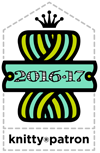Feature: Knittyspin
INTRODUCTION
Knittyspin
Bring Out Your Cards: Carding for Color
Carding isn’t just for fleece! Preparing fiber from a fleeces isn’t one of my favorite things, but I still spend a fair amount of time carding. I love to card for color.
Carding for color is like mixing paint or dye. I can get the exact shade of a color I want. It’s addictive and fun, plus if you are hesitant about carding or feel like your carding skills are lacking, carding for color is a great way to practice. And working with color in small increments that you control is a perfect way to boost your color confidence.
For a particular project I have in mind, I need a deep purple, maybe even with a little murk or dark in it. I grab red and purple, white and grey Corriedale from Louet, my electronic scale and my favorite cards: Louet extra-fine cotton cards. Yes, I use them for wool. They are bouncy and make my carding fast and easy.

When I blend for color, especially when I’m first figuring out ratios of color, less is more. I work with a total of .10 of an ounce of fiber at a time. My electronic scale goes down to three spots past the decimal, so I can adjust in wee increments, if I so choose. It’s a very manageable amount, easy to card and blend quickly, and it’s easy to do the math to divide the colors.
When I load my card, I alternate colors on the first layer and then do the opposite on the second. I work with between three and five passes back and forth on the cards to get the color blended. I don’t blend my color so it it’s mixed 100% because I like a little variation in my yarn.

Left: handcards loaded – Right: blended
I quickly carded and spun five different yarns, changing the ratios or color balance each time. In a very short time, I had quite a range of purples, shown below. A is 50/50 red and blue, B is more red than blue, C more blue than red, D has a bit of white in it and E has a little grey. Let’s look at them a little more closely.

Five different types of purple
First up my 50/50 blend, equal amounts of red and blue. If I’d ever doubted the visual power of red, I doubt no longer. I’m not sure I’d call this color in the rolag or yarn purple exactly, it’s not-exactly-purple, maybe red-purple. It’s a great rich color, but not what I’m looking for.

50 red/50 blue
Next I worked with 75/25 ratios. Because I wanted to see if the blue made a dent in the red at all, I carded and spun a 75 red/ 25 blue yarn first. It made a super sexy blue-red, but no one would ever call this any shade of purple.
75/blue and 25/red is what I’m talking about when I say deep purple. It’s rich yet has variation, but there is no mistaking it for any other color but purple. This is 90+% of the color I want for my project.

Left: 75 red/ 25 blue
Right: 75 blue/ 25 red
But remember I said I might want to add a little murk to it, a little dark edge? I carded and spun two more yarns with a majority of blue, but adding white to one and grey to the second. The ratio was 70 blue/20 red/ and 10 in either white or grey.
The little extra white or grey changes the base dark purple just a little. The white lifts it slightly making it brighter, and the grey takes the purple down deeper. The two neutrals add a halo of light or dark to the yarn.

70 blue/ 20 red /10 white or grey, adds further depth to the purple
I don’t see it as much in the rolags, in fact I had to keep them very separate and marked while I was working, but in the yarn there is an absolute difference.
When I first glanced at the yarns, they didn’t look too different. But when I put the yarns right next to each other, I could see it. A little bit of darkness to the yarn with the grey added in. That is the color I want. I may still monkey with it a little more adding more grey, just to see what happens. I have a feeling it will lose the crispy purple and become more muddy, but I have to try.

top: dark purple with white
bottom: dark purple with grey
A little change can make the difference between a color that you want and a color that goes perfectly or a color that is just ok. Look at the three dark purples side by side. Not a lot of variation at first glance, but when you look closer and especially when you start knitting with them there’s a world of difference in there.

middle: 70 blue/ 20 red /10 white
bottom: 70 blue/ 20 red /10 grey
Bring out your cards and all your solids and whip up some perfect colors.
Hat tip to Beth Smith, queen of the hand preppers, for being my carding Yoda and for telling me about the Louet handcards.





 Jillian Moreno is the editor of Knittyspin. She's on the Editorial Advisory board for
Jillian Moreno is the editor of Knittyspin. She's on the Editorial Advisory board for